Open my heart, and you will see Graved inside of it, “Italy.”
They call it bella figura. Like style, it is easy to recognize but cannot be simply explained. Loosely translated, the message, it seems, is that making a good impression is everything, which, naturally, is easier said than done. For doing so not only consumes enormous time and energy but also is comprised of endless possibilities darting in a blur—from the way one stands, speaks, walks, and dresses to one’s manners and the manner in which one bedecks the home and entertains.
Indeed, bella figura means different things to different people, with varying interpretations clearly being shaped by interests and tastes when it comes to fashionable interior decorating and design. Some see it as rich colors, a savvy mix of fabrics from the finest mills, hand-painted antiques, and mellow old woods with warm patinas. For others, it is the luxury of comfort, interesting collections, and the veneer of elegance. And for still others, it is the improbable beauty found in distinctive details that flatter a room.
Say what you like: bella figura is not an easy thing to come by. Neither social cachet nor money offers any guarantee of making a positive impression. But, then, even in a demanding world we would never be content to let family name, net worth, or appearances define us—as that would be considered gauche.
It hardly matters, though. Despite cultural differences, the French and Italians alike have become our passports to good taste, the latter luring us with their passion for life, innate warmth, and reliable images. As if this were not enough, we look to the Italian people for unassuming ways—both obvious and subtle—of living, entertaining, and decorating.
Needless to say, our appetite for all that is Italian is not out of place. After all, few countries elicit awe quite like Italy. While its bureaucracy can be mystifying, its exceptional beauty is an ongoing feast for our admiring gaze, its tangled history, assimilated culture, and relaxed sophistication sources of endless fascination.
Seducing us are case coloniche —the typical Tuscan farmhouses steeped in countless charm; sun-bleached villas with easygoing elegance; and their extravagant, more celebrated cousins—sumptuous palazzi whose au courant proportions merit high praise. In the midst of such plenty are the landscapes that inspired Renaissance artists Leonardo da Vinci, Raphael, and Michelangelo, framed by vineyards, olive groves, and neat rows of cypress trees.
In each of Italy’s twenty-one regions resides unique character and charm, stemming from the customs, climate, and terrain. But it is centrally huddled Tuscany, Umbria, Marche, and Lazio, awash with old-world rhythms and a colorful air, that have given life to the style known as Italian Country, which has since proven irresistible. And no wonder. Despite exterior trappings or how intimate the enclosures, interiors resound with an unabashed reverence for beauty. Yet settings are distinctly Italian: expressive, airy, and, most importantly, inviting. Much like the country’s undulating cities and towns, each has its own easy way of welcoming the steady flow of relatives and close friends central to life.
Never mind that Italy has a staggering number of congenial places to dine—some pricey, but also a wealth of reasonable ristoranti and even less-expensive small trattorie, or taverns, not to mention unpretentious osterie, or wine bars in busy neighborhoods that lend themselves to people-watching. Stopping by each other’s homes is practically a daily ritual (which, in fact, may be why young men in Italy are all too often known as mama’s boys), if not to share lingering meals, then for the sole purpose of doing nothing more than relaxing, thus preserving the tradition of dolce far niente, or sweet idleness, while sipping espresso.
Though tastes differ, unforgettable colors, sensuous textures, and fluid, natural fabrics—including revered Fortuny prints now printed on cotton only—mingle with customary Italian flair, gently jarring spaces that might otherwise appear too serious with a sense of delight.
Somehow, the sturdy silhouettes of finely crafted commodes, tables, and chairs with a former life manage to speak for themselves, without any one piece being too forward. Chandeliers worthy of the country’s artisans flicker in eye-catching mirrors hung opposite one another, giving even small quarters more presence—though size, Italians argue, has nothing to do with style.
Since there is an aversion to heavy window treatments, tiebacks are shunned in favor of free-hanging curtains with minimum fuss. Memorably patterned stone floors meanwhile bask in one another’s reflected glow, rarely spoiled by rugs.
Faithful to their heritage, antique tapestries meander through unpretentious villa halls, accompanied by cherished centuries-old paintings, some in need of cleaning. In truth, there is little doubt these days that most families live amid furnishings collected over several lifetimes, thoughtfully handed down generation after generation by caring ancestors—as if confirming once and for all what Americans have known all along: being the favorite has its privileges.
While next of kin may vie for a desk piped in history or covet a mosaic-topped table and a commode with marqueterie finer than another, in reality, living spaces are generally sparsely furnished and, almost without exception, shy of pretension. Quite simply, in Italy affectation has no place. And neither does clutter that might deter guests from moving about freely during, say, a pre-opera buffet.
True to tradition, comfort abounds—meaning that artistic merit does not take precedence over indulging family or pampering friends. Beside a chair, there is always a table big enough for a glass of wine and small plate of cheese with sliced salami and olives; there are pillows to relax against; soft, clinging shawls to gather for added warmth; and table and floor lamps placed just so for ending the day with La Repubblica or another of Italy’s well-known daily papers. (Low lights are for entertaining only.) There is even a chair next to the bathtub for stacking towels, placing a robe, or relaxing upon while the tub fills.
Although the commonplace has never received the universal admiration of more important Italian pieces, the deft layering of the conventional with the glamourous makes stylish living look effortless, which is no small feat.
As it is, stately andirons, antique altarsticks, priceless clocks, and libraries of leather-bound books project an air of authority, while firescreens, planters, close-ups of family and friends, and bountiful bouquets, smartly arranged, plump settings with backdrops for handling the cares, concerns, and aspirations of everyday life.
Without fail, and without the princely prices of Le Sirenuse and other luxury hotels on the thirty-mile stretch of Amalfi Coast, impeccably pressed linens stretch across beds, hinting of femininity. Down-filled bolsters sprawl beneath soft down pillows as feather beds snuggle against mattresses. Modest box springs appear tightly wrapped in blanket covers, shielded from prying eyes.
Given that Italians balk at like furnishings lacking character, most cannot imagine awakening in a bed flanked by identical night tables covered with similar lamps, resting near a matching dresser or chests of drawers. Not that the younger generation, any less than their parents, does not consider nonna’s armoire a wardrobe necessity. It does. But filling empty rooms with shiny new suites without any mystique, rather than mismatched antique pieces, is not something they understand.
To their way of thinking, it is unpardonable to live in a house full of rootless pieces with no ties to the past or any sentiment attached. Furnishings must be as meaningful as they are decorative, with the secrets and bruises of history opening a window into the Italian way of life.
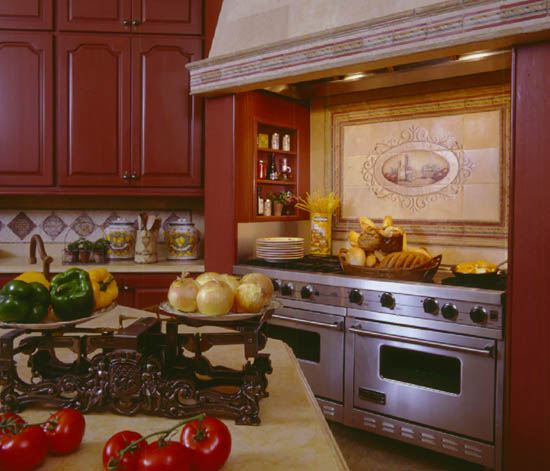
“Mangia bene, Vive bene,” (“Eat well, Live well”), the saying that is an Italian icon, brings to mind thoughts of pasta—a traditional first course—followed by meat, game or fish. For eating well no longer means just pasta and piazza any more than living well requires suppressing one’s taste and preferences. Here, glazed red cabinets keep clutter to a minimum. Easy-care stone sweeps countertops and floors. Further setting the kitchen apart is a gleaming stainless-steel stove, which is not reserved for a professional chef but does offer an endless variety of Italian dishes.

Surrounding the trestle table made of aged wood are reproduction chairs with backs upholstered in hand-tooled leather. The uptown sofa, covered in Veronese hand-stamped velvet, is by Rob Jones. King Custom Draperies, of Houston, fabricated the pleated gray silk from Gretchen Bellinger as well as the Scalamandré silk panels. Beneath the Dutch landscape, dating from the nineteenth century, sits an eighteenth-century Italian server from Houston’s Brian Stringer Antiques.
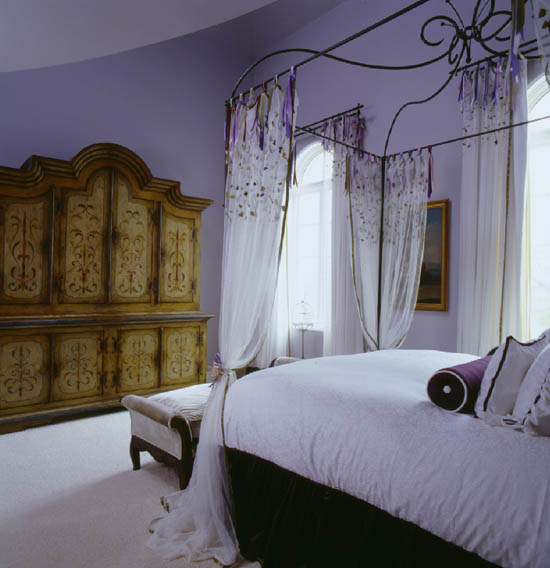
While some young girls may take their inspiration from Kay Thompson’s hyperactive Eloise, who orders from room service, rides elevators, and roams the halls of New York City’s Plaza Hotel where she lives, Eloise would undoubtedly cast an approving eye on a more feminine yet less snobbish sort of place. An antique bench pays homage to the French, while sheers from Creation Baumann, Los Angeles, filter the light. Having all the makings of a family heirloom is the hand-painted Brazilian cabinet, a reproduction from the Roberta Schilling Collection in Miami.

A kitchen sizzles with the allure of Italy when old-world styling meets forward-looking flair. As if trumpeting the country’s penchant for innovative design, the beamed ceiling looks down on tile inlaid with individual pieces of hand-painted pottery, each different. The result is not only a visual treat but also a warmth most inviting.
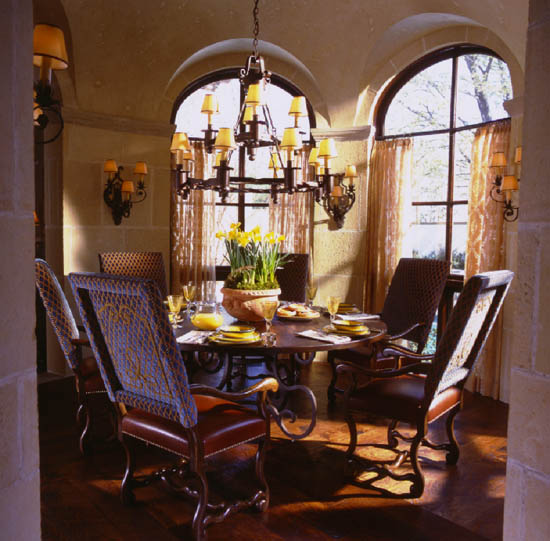
Lunch in Italy is generally eaten at one o’clock; however, mealtime may stretch out for hours. Here, a distinctive octagonal space off the kitchen serves as the informal dining room. The backs of new Dennis & Leen chairs are upholstered in a Brunschwig & Fils fabric. Seats are covered in leather. Antique sconces circle the room, with each lauding a different motif relating to France.
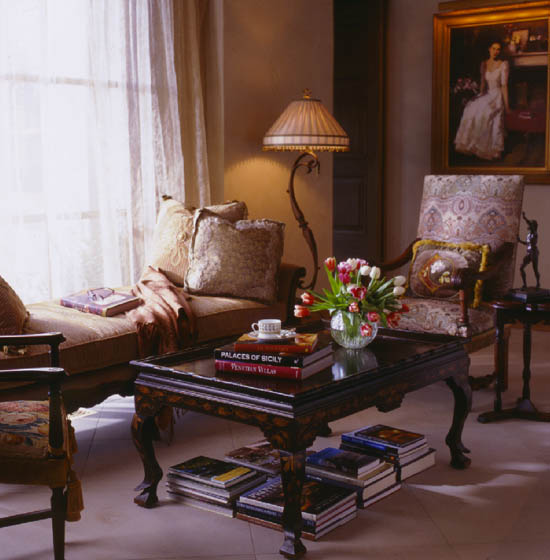
At the side of a music room a daybed offers intimate seating, while a coffee table provides a place for drinks. The coffee table is an innovation of the last century.
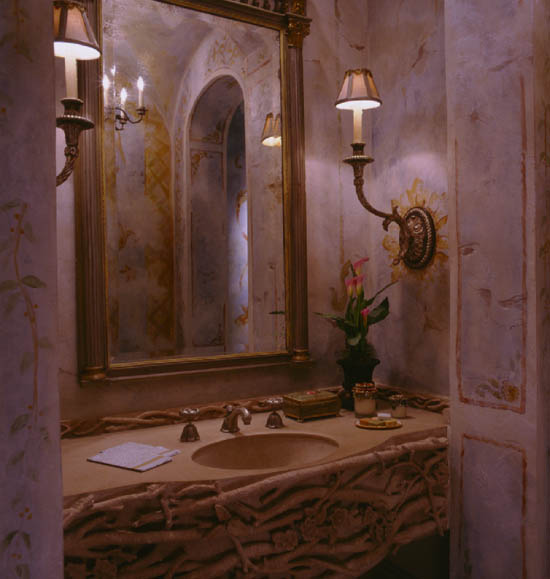
In eighteenth-century France, powder rooms were intended for powdering one’s wig. Nowadays a sculpted niche like this offers more than a place to primp; it captures endless admirers. With a contemporary air, the hand-carved stone vanity hides plumbing while layer upon layer of glaze gives rise to walls that look convincingly old. Decorative painting is by Jer Giles Artworks of Lancaster, Texas.
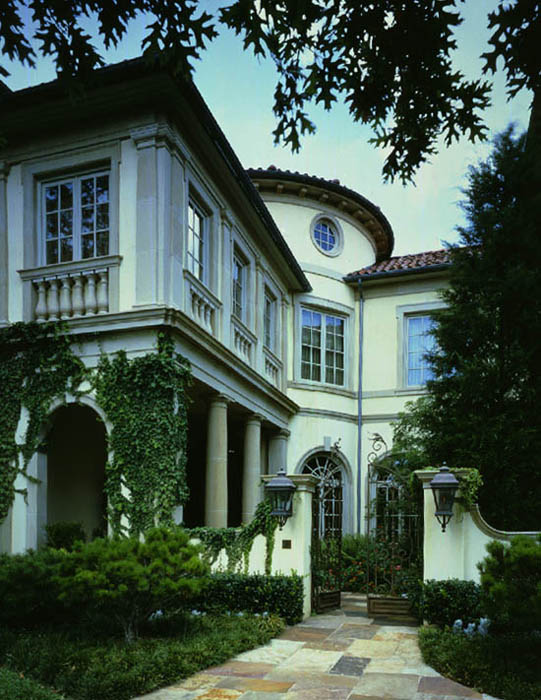
In a triumph of ingenuity, a villa designed by Richard Drummond Davis reflects the classic architecture of Tuscany. Soaring stone stairs, some with fossil traces, imbue the home with old-world sophistication, yet it is stocked with more amenities than most five-star hotels.
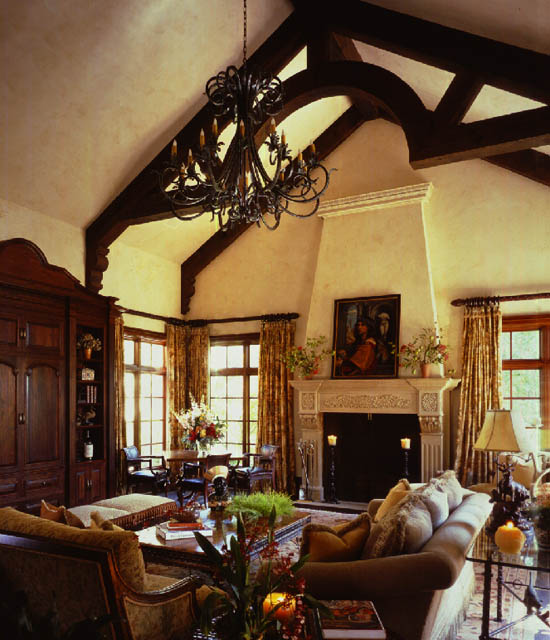
A panoply of styles and cultures mingle amiably, delivering the best of various worlds to an Italianate villa. But in the midst of such lofty grandeur, a limestone fireplace carved by Harold Clayton of Dallas unabashedly takes pride of place. This is not to say that anything could obscure the importance of the Oriental Soumak that anchors the room. The family room’s understated elegance also stems from an arrangement by Judy Blackman Floral Designs, Dallas.
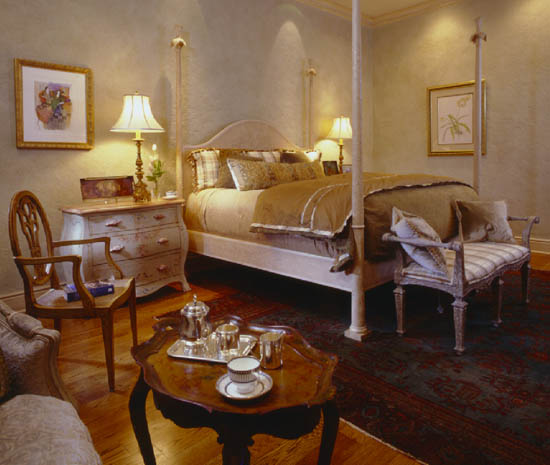
An Italianate painted bed—the Friuli from Patina—along with the firm’s Veneto bombé chest elevate off-hand glamour, while a rare Persian Mahal Sultanabad antique area rug anchors the room. Meters of fabrics and passementerie , plus objets d’art culled from abroad, further the classic European country ambience.
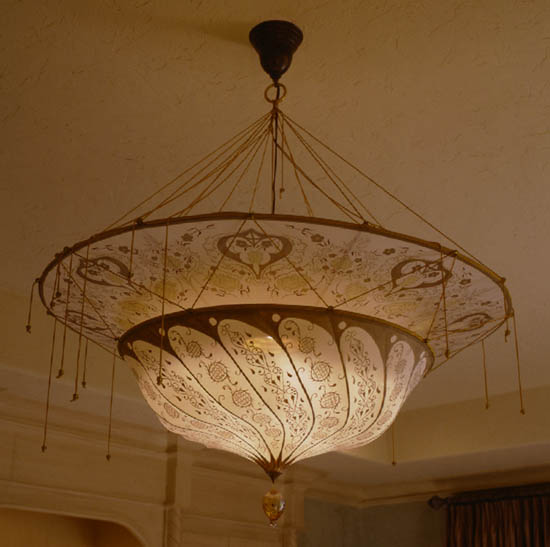
Admittedly, Americans have a passion for beautiful handmade lamps. A Fortuny-like hand-painted silk chandelier accessorized with beads hangs from the ceiling above the bed.
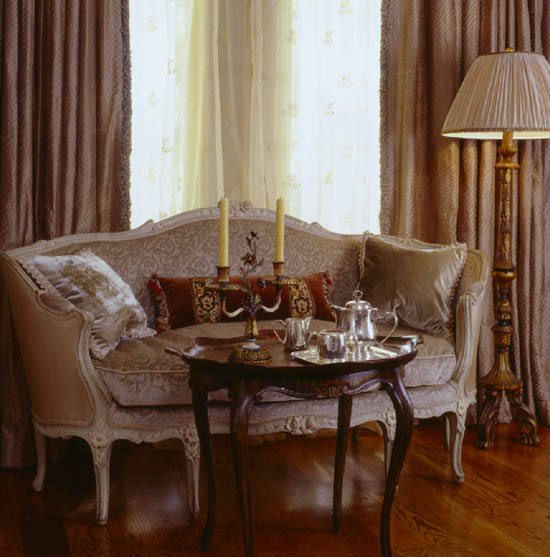
The master bedroom is home to this , which is also known as a canapè in France—or more specifically still as an ottomane, given that it is basket-shaped with an enclosed back that arcs gracefully forward. It was purchased at Kay O’Toole, Houston, then reupholstered in a Veronese hand-printed velvet.

In Italian bathrooms, where the palette rarely strays from the neutrals, soft white towels, bath oils, and scented sea salts with stress-relieving properties are not enough to bathe one in luxury. Natural light ranks near the top of priority lists. Jostling for space beside the Peter Fasano wallcovering are mosaics in the style of the Roman Empire from Walker Zanger. The curtain is constructed with Nancy Corzine fabric. Houston designer Marilyn Phillips happened upon the terra-cotta urn dating to the nineteenth century at Marchè de la Porte de Vanves, in Paris.
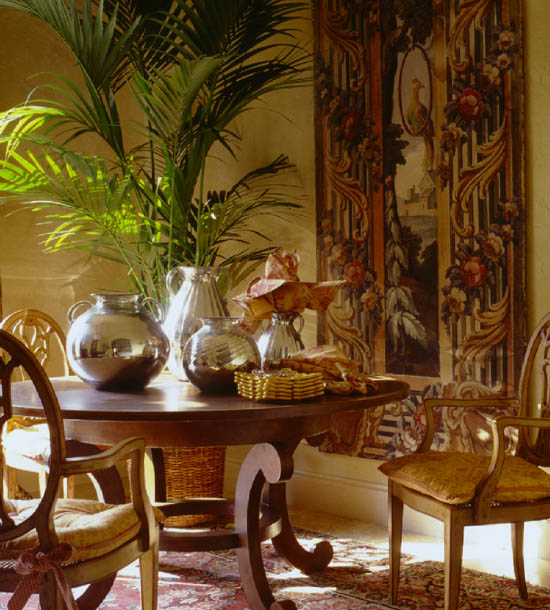
Pride of place goes to ten-foot-tall oils on canvas—one unseen—that in the nineteenth century hung in a Paris bistro. Which is not to say the collection of vintage mercury glass, or silver glass, as some experts say the objets d’art adorning the dining table should be known, is not deserving of attention. Once also called “poor man’s silver,” vases such as these French flea-market finds are nowadays boldly sought. At night, shimmering candlelight adds to the gathering’s glow.
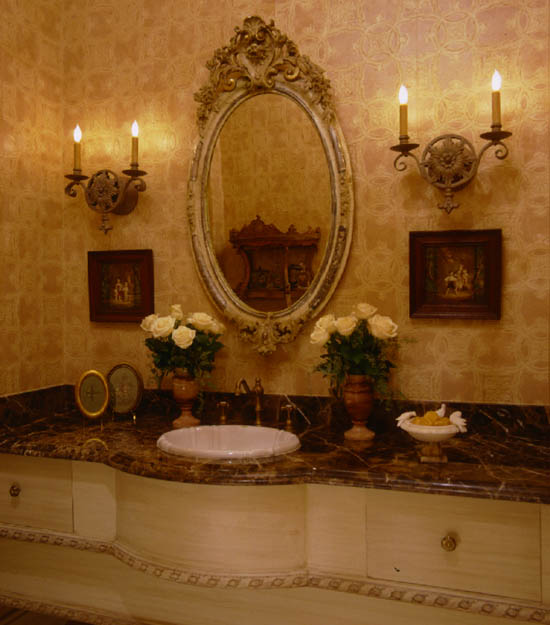
France and Italy mingle adeptly in a powder room brimming with antiques. The étagère, mirror, and pair of porcelain hand-painted tiles are all French, dating from the nineteenth century. From the same era is an unseen Italian chandelier.

Once upon a time, children’s rooms had to look juvenile. But what a difference a few decades make. Today, schoolgirls are much more sophisticated. To be forever cherished is the vintage writing table—freshly painted in Italy—culled from Brian Stringer Antiques, Houston, plus a custom-colored four-poster bed from Jane Keltner Designs in Memphis. French prints dating from the nineteenth century were discovered in the Paris flea market Marchè Serpette. Meters of “Les Jardinanglais” from Marvic Textiles lead the way to the stylish bedcovers. Parchment wallcovering is by Zoffany.
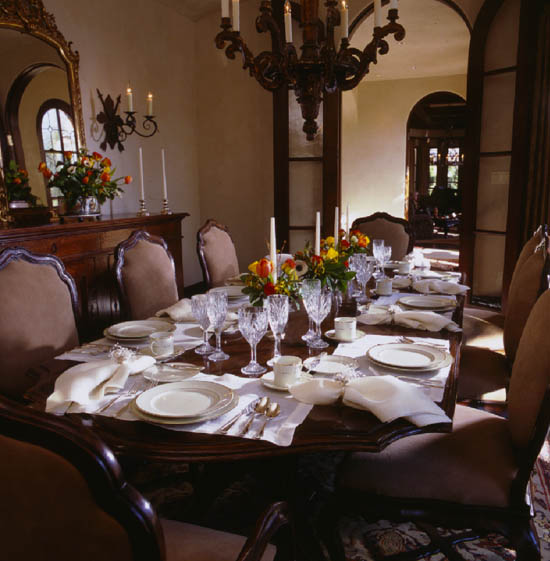
In a dining room with a degree of formality, there is a sense of comforting richness. While stainless silver becomes duller with use, sterling ages gracefully, as long as it is used rather than kept in a cloth-lined drawer. Although European flatware is larger than that produced in America, American sterling has a higher silver-to-copper ratio, as if polishing its image by honoring the universally accepted .925 standard established in the fourteenth century. But because continental pieces are bigger, the weight of silver grams is generally higher. Just as importantly, though, Italian and French flatware feels as luxuriant as it looks, and that is what makes it so appealing.

A chorus of chairs in concert with rich woods and antiques culled from American sources are key to a music room’s harmony.

Houston designers Clair and Cecilia Tally transported their chic style to a classic villa, creating a smartly dressed breakfast room that makes each new day ever more special.
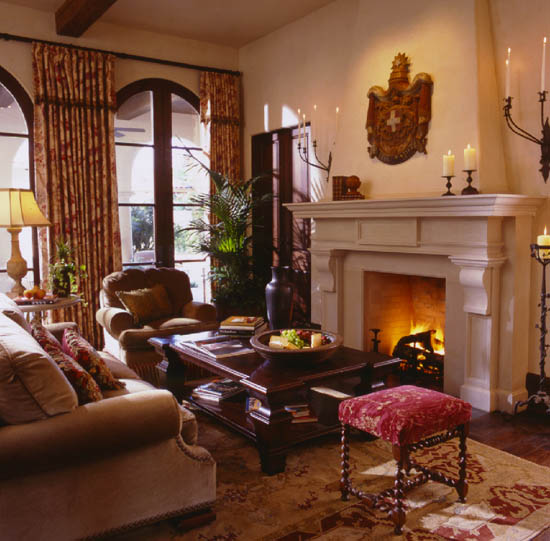
With elegant ease rather than the haughty look of Parisian domains, a family room evokes a feeling of casual grandeur that encourages guests to linger.

In a master bedroom, Dallas designer Margaret Chambers pairs seductive chocolate with tones of cream and taupe that melt to create understated bark. Flannel interlining adds weight to the bed hangings and curtains, giving them an appearance that is unmistakably grand.
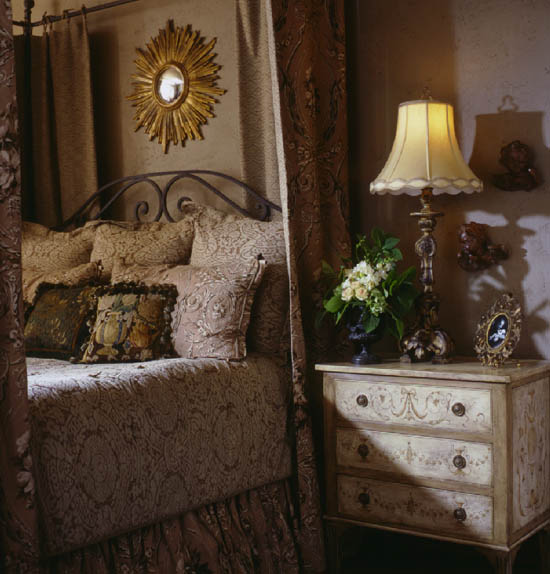
A detail of the master bed. The hand-painted Italian chest offers extra storage. The Aubusson pillows are antique. The French sunburst, circa 1880, is another flea-market find.
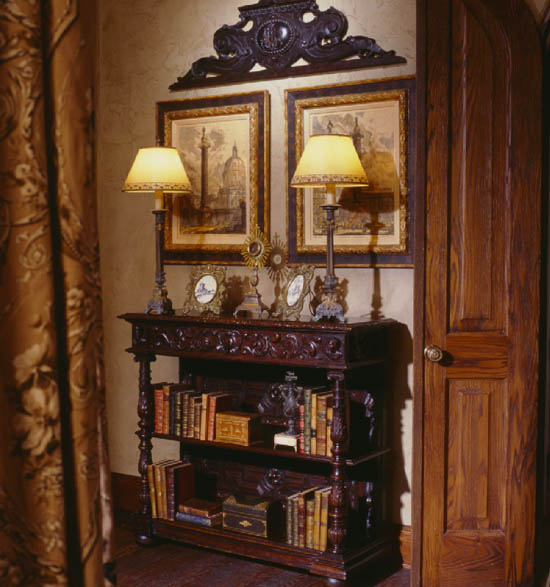
On a wall in the master bedroom stands a late-nineteenth-century hand-carved French bookcase laden with treasures that blur the boundaries between Italy and France. From Italy come hand-painted prints and antique hand-tooled leather boxes, while the altarsticks traveled from France and were later made into lamps.
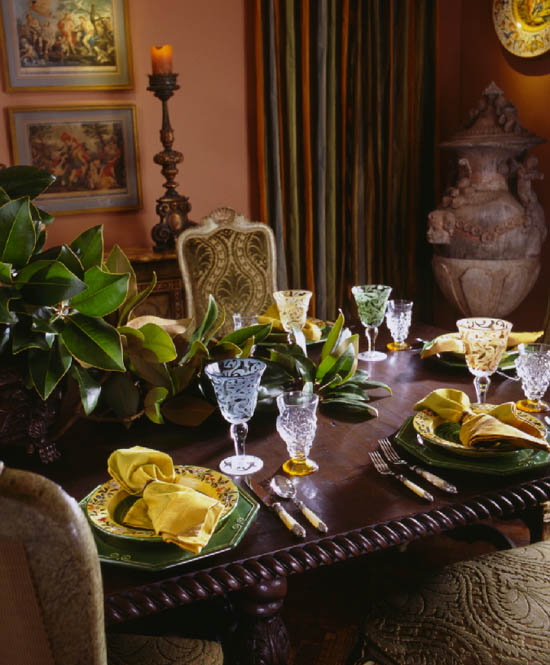
A sophisticated mix of Italian tableware from Stanley Korshak, Dallas, radiates Mediterranean splendor, while centuries-old Italian prints and an antique platter paint this dining room with further importance. The stone urn was stumbled upon in France. The reproduction table and chairs are worthy of the setting.
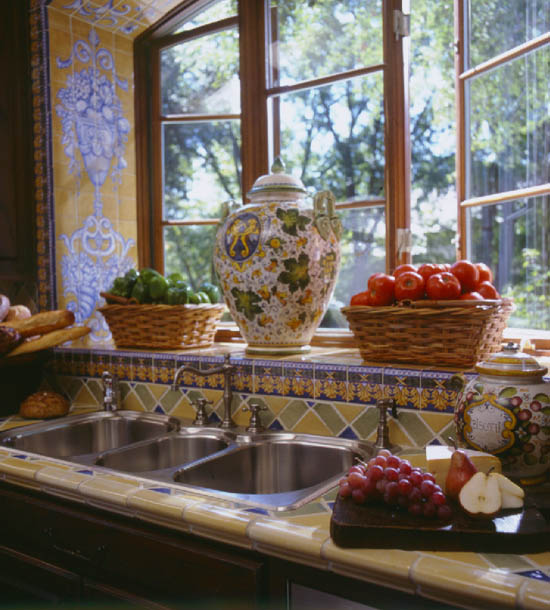
Abroad, street markets brim with vegetables, fruits, and flowers bound for European homes. Rivaling the charm of rural Italy, hand-painted tile frames a kitchen window here in the States. The admirable field tile is from Walker Zanger showrooms, nationwide.

A family room isn’t complete without a cushy sofa, comfy pillows, and good-looking chairs. Add some imposing antiques, an unforgettable sunflower bouquet, and a collection of design books, and you have the makings of the perfect setting for lingering over coffee or talking about ambitions.
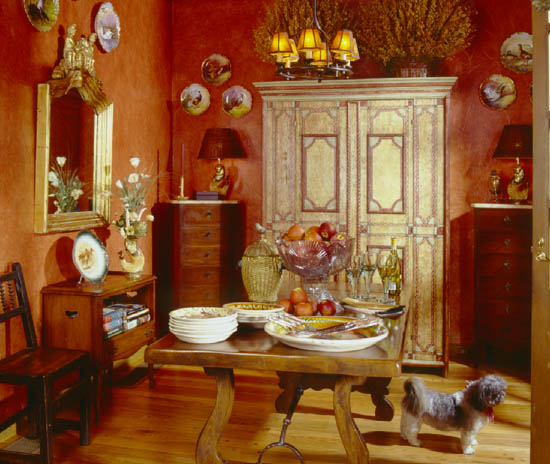
A former servants’ kitchen gave way to an inviting breakfast room reminiscent of the nineteenth century. Charm comes from the color-washed terra-cotta walls, a painted armoire happened upon in Tuscany, and the adored dog. Antique plates are Limoge, from the French city known for its porcelain.

In a bow to Italian life, Florentino chairs surround a dining table from Genoa while the floor is paved in antique brick. The console was found in northern France—so close to the Italian border it is hard to pinpoint its origin. Upon it sit charming, hard-working crèche figures called santos, meaning little saints, rooted in sixteenth-century Italy when public displays of faith were banned. The ones seen here actually are from Spain and Portugal, dating from the eighteenth and nineteenth centuries. The painting is by Fleur Cowles, publisher of the fabled Flair magazine.
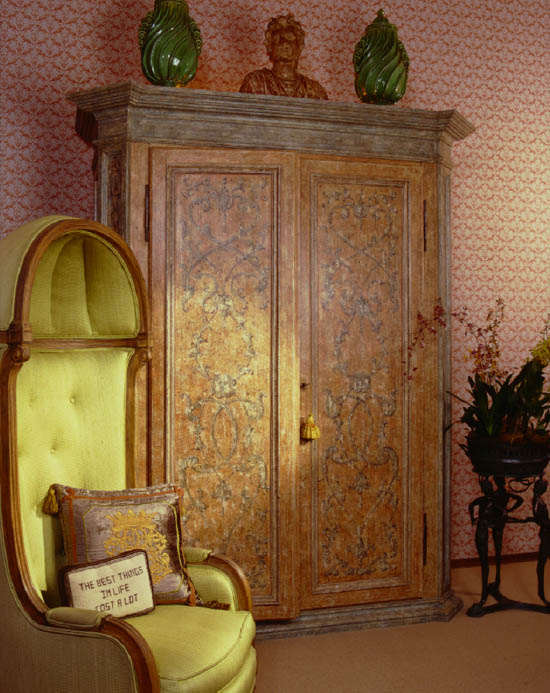
Plying a reading room with worldly style are graceful, beautifully proportioned pieces. The painted cabinet serves as a dramatic focal point, providing storage for everything from engraved correspondence cards to classical compact discs.
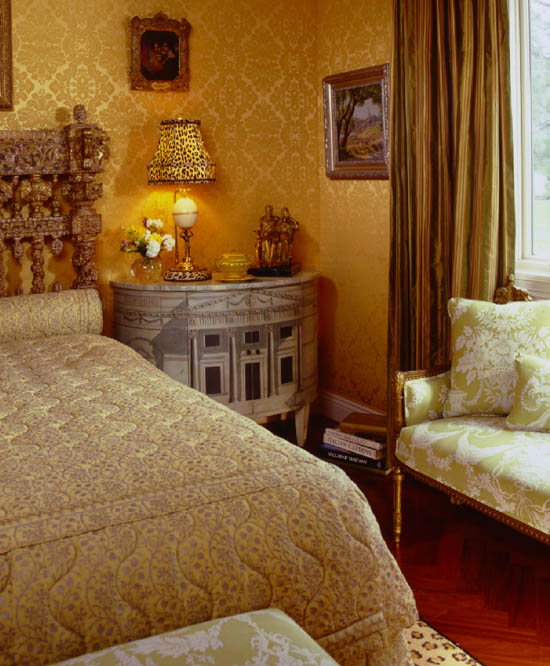
A magnificent seventeenth-century Portuguese headboard shrouded in mystery offers a priceless glimpse of the past. Meanwhile, the Louis XVI settee shows off its fluted legs, plus a sexy silhouette. Dusted-off family heirlooms set the mood. Ancient Romans used both gilt and gold to define social position and wealth.